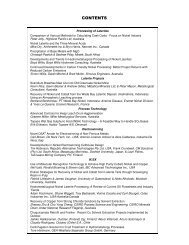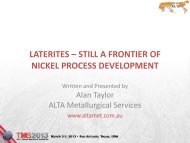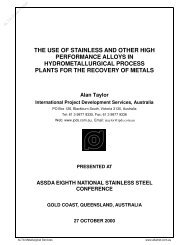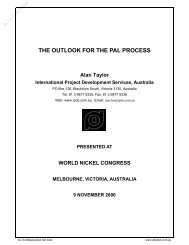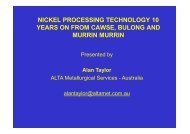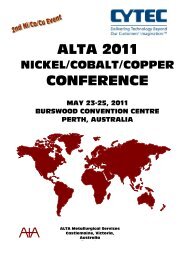solvent extraction mixer-settler design - ALTA Metallurgical Services
solvent extraction mixer-settler design - ALTA Metallurgical Services
solvent extraction mixer-settler design - ALTA Metallurgical Services
You also want an ePaper? Increase the reach of your titles
YUMPU automatically turns print PDFs into web optimized ePapers that Google loves.
<strong>ALTA</strong> Free Paper<br />
serves to dampen solution movement and act as a supplementary distributor. Some <strong>design</strong>ers<br />
eliminate the distributor and rely solely on a picket fence. Others add a second or even third fence for<br />
some applications. The authors consider a well <strong>design</strong>ed distributor to be highly advantageous. Full<br />
width organic and aqueous weirs are shown to minimise the discharge velocities. The aqueous<br />
discharge weir box is fitted with a secondary (advance) weir to facilitate the separation of a portion of<br />
the aqueous flow for recycle to the mix box. This may not be required in some cases, and in others it<br />
may be necessary to provide an advance weir in the organic weir box, or even in both boxes. It is<br />
recognised that some <strong>design</strong>ers use other recycle arrangements, but the authors have found this<br />
particular concept to be successful and easy to operate. By giving the recycle “first bite” of the<br />
solution, it provides a constant hydraulic head for the recycle stream, which can otherwise be difficult<br />
to control. The solution leaves the <strong>settler</strong> via the advance weir box, which provides limited surge<br />
capacity for flow variations. All of the discharge pipes are fitted with manual control valves. It is<br />
good <strong>design</strong> practice to install a simple vortex breaker at the inlet to each discharge pipe. Generally,<br />
the discharge pipes are connected to the bottom of the weir boxes to avoid air entrainment, which can<br />
lead to crud formation and increased entrainment losses.<br />
Mix Box Details<br />
The required overall retention time is set by testwork, the extractant supplier’s recommendation and<br />
industry practice. Typically, it varies from 1 to 5 minutes. The mix boxes are <strong>design</strong>ed to provide this<br />
under dynamic operating conditions. This means that the operating crest on each mix box and the<br />
volume in the downcomer (or upcomer in some <strong>design</strong>s) is included. Commonly the mix boxes are<br />
<strong>design</strong>ed with the same external dimensions for ease of construction, though some <strong>design</strong>ers prefer to<br />
use a smaller first box. The height of each box is generally minimised to reduce construction costs,<br />
though this may not be important for smaller plants. Care must be taken in setting the active solution<br />
height to avoid vortexing and air entrainment. Typically, a minimum aspect ratio (active height to<br />
vessel diameter) of about 0.6 is employed. Adequate freeboard must be allowed in each mix box to<br />
account for the crest heights, which depend on the mix box dimensions and the pressure drop through<br />
the system.<br />
In Figure 2, the first box is fitted with a false bottom to which the organic and aqueous feed and<br />
recycle pipes are connected. The aqueous and organic must be kept separate by installing dividers in<br />
the false bottom, otherwise the organic flow will be hindered due to its lower density. If the recycle<br />
line is <strong>design</strong>ed for dual use (ie aqueous or organic), it must have its own separate compartment in the<br />
false bottom. Some <strong>design</strong>ers use a “boot” protruding below the base of the mix box, instead of a<br />
false bottom. This may be an extension of an internal draft tube, which is used in some installations.<br />
In another variation, especially where the piping is of very large diameter, the false bottom is extended<br />
up the sides of the mix box in order to provide sufficient area for the pipe connections. Following<br />
conventional mixing <strong>design</strong> practice, vertical sidewall baffles are used to promote proper mixing<br />
patterns. Each box is fitted with a horizontal baffle at the top overflow port to reduce short-circuiting.<br />
Sometimes anti-vortex baffles are installed near the top of the first mix box, especially when the<br />
pump-mix impeller is mounted higher up the vessel in conjunction with a draft tube. The dispersion<br />
formed in the first mix box enters the second stage via a downcomer to avoid short-circuiting. In<br />
some <strong>design</strong>s, the downcomer is mounted in the first mix box. In comparing various <strong>design</strong>s, it should<br />
be recognised that the <strong>design</strong> features are often influenced by the preferences of the <strong>design</strong>er, as well<br />
as by plant layout and materials of construction issues.<br />
A variety of pump-mix impeller <strong>design</strong>s have been used over the years. As plants initially grew<br />
larger, especially for copper SX, the applications lay outside of the experience of the equipment<br />
suppliers, and the impellers were generally specified by engineering firms and consultants. The most<br />
common <strong>design</strong> was the single shrouded type with six radial straight blades mounted over a cylindrical<br />
hole at the bottom of the mix box (which became known as the General Mills impeller). The other<br />
common type was the double shrouded type with eight radial swept-back curved blades, usually<br />
elevated to about one third of the liquid depth and fed by a draft tube (Davy BB impeller). Key issues<br />
are to provide adequate pumping head and mixing power, while minimising the formation of fine



